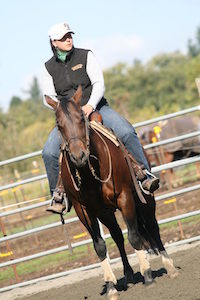Strategies to Help Make Every Ride Count
by Allison Trimble

When training a horse, there are so many things to take into consideration that it can become a bit overwhelming. One article says this, a video says that and another clinician said something different. How does a person know what to believe? It isn’t always an issue with the information provided—each of them can be right in context, but with the daily application at home.
Not everyone starts their own horse from the ground up. That can make it difficult to have a handle on the big picture, on how a horse should be introduced to things in a formative way. Personally, I want each horse to respond willingly to cues, with confidence, and I want my horse to trust me so that he may follow my lead at all times. There is no drill, or trick, no stick or treat that can replace trust.
So, how is that trust built? I believe it is built through a series of successful rides that build a solid foundation. A “successful” ride means that in each working session the horse had moments of pressure that caused uncertainty, but was led by the rider to the proper response gaining release and the ride ended on a good note. Strung together, those kind of rides build a confident, trusting horse that will follow its rider. Here are some tips to help garner successful rides.
- Be present the entire ride. Each day a person brings the rest of their life to the arena—both good and bad. Remember that the ride starts from the moment the horse is approached to be caught, and ends when they are released back to the stall or field. Every encounter with a horse is either training, or un-training them. I often see the root of problems in places other than the arena.
- Too much, or not enough? There is a delicate balance between pushing a horse too hard, and not asking enough of him. The horse that is pushed too hard can be unable to find release and become scared or untrusting. The horse that is not challenged enough can become pushy, or rude. Pay close attention to the horse. If he starts to become fearful more often than he is confident perhaps it is too much, too fast. If the horse is distracted or outright naughty, put him to more work.
- Never underestimate the power of a good sweat. Unsuccessful rides often occur because the rider was trying to train the brain of a horse that was altogether too fresh to think. If the horse is having a tough time focusing, healthy oxygen flow works wonders.
- Set the horse up for success, not failure. The goal should always be for the horse to find the release from a cue. The rider should have a clear idea of what the cue will be, how to escalate to encourage the proper response, and at what point the release will come. If the rider does not know those three things, there is little chance the horse will.
- Movement towards the proper response can mean as much as the proper response. A person can so fixate on a desired outcome it makes them unable to recognize when a horse is taking a positive step forward. It is important to recognize and reward try in the right direction, especially when the task is particularly hard for the horse. Once encouraged, the horse will often offer the rest of the response.
- After a bad ride all is not lost. However, there must be even more thought put into the next ride. I see folks go right back at the thing that caused all the frustration, or the wreck, first thing the next ride. The horse has not forgotten yesterday either. It’s best to get a couple successful rides—doing something you both can confidently accomplish— to regain trust and willingness. Then approach the troubling situation in a new way.
- Know when not to ride. There have been many days that I knew I shouldn’t ride. I was so preoccupied with life’s troubles, or just knew I couldn’t do my job well that day. Remember that one bad ride can erase weeks, months, or more of good rides. Know your own limits.
Remember, successful rides build trust and trust is the foundation of your relationship with your horse.
Originally Published July 2014 Issue

Allison Trimble is a Realtor® specializing in equestrian properties, farm and ranch properties, and residential real estate. As a former horse trainer, and a current owner, breeder and non-pro competitor in cow horse and reining events, she combines her experience in the horse industry with her lifelong real estate expertise to guide her clients through the real estate process.
Learn more at www.coastalrealtywa.com

